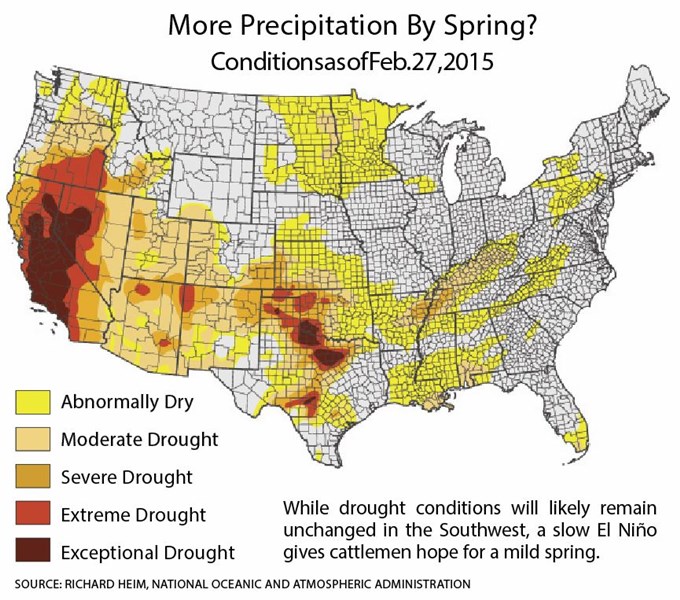Favorable Spring Forecast
CattleFax predicts a cool start to planting and mild summer temperatures
Cattlemen at the 2015 Cattle Industry Convention heard an overall favorable spring weather forecast for cattle, crop and forage production.
(Click the image for larger view)
Persistent warm waters from California and Baja to Hawaii favor normal weather conditions in the Plains and Midwest this summer, said Art Douglas, professor emeritus, Creighton University, during the Cattle-Fax outlook session. Dry conditions might develop across the Southern Plains with this pattern, but the Midwest should avoid a hot dry summer.
However, with oceanic and atmospheric indices shifting away from El Niño, it is not surprising the January to March forecast shows a shift away from a classic wet, mild winter for much of the country.
“This has been the most up and down, hard-to-predict El Niño that I can ever remember,” Douglas said. “It’s supposed to peak in December, not in June.”
Even the National Oceanic and Atmospheric Administration (NOAA) model is a bit confused—it doesn’t know if will be warm or if its going to be cold, he added.
The difference in this El Niño is that the warm waters that would develop in Southeast Asia are further west. “It looks like we are going to have two years of El Niño,” Douglas said. “This El Niño is simply slow.”
Looking forward to spring planting, grazing and forage production, Douglas pointed to areas of persistent drought and areas of recovery.
“Percent normal precip [over the past 90 days] has only been good in the far Southern Plains and Texas area, as well as the plains of eastern Montana. We have lingering drought throughout the western U.S. and portions of the Central Plains. California is still in extreme drought conditions. We are going to keep working on that for the next three or four months. Same way in the Southern Plains—even though we’re starting to see moisture there, drought is still considerably strong,” he said.
“As we get into spring, we are expecting a trough in the southern Pacific to get stronger,” Douglas said. “There is going to be a squeeze play between a trough on the coast and a trough in the eastern U.S. We’ll get good moisture into the Southwest, but its going to be harder for moisture to get into the Southern Plains.”
Temperatures in March should be warmer than normal in the West but cool all the way through the central part of the country. Cooler weather comes in again for April and warms again in May. “You’ll probably have some delayed planting due to the cool temperatures,” he said.
The Midwest is likely to remain drier than normal into spring with temperatures averaging below normal through February and possibly March. Drought conditions are likely to remain unchanged from northern California into the northern plains and upper Midwest.








